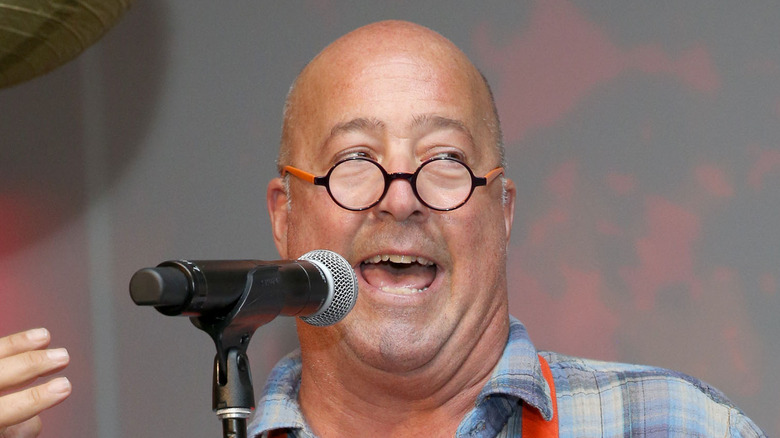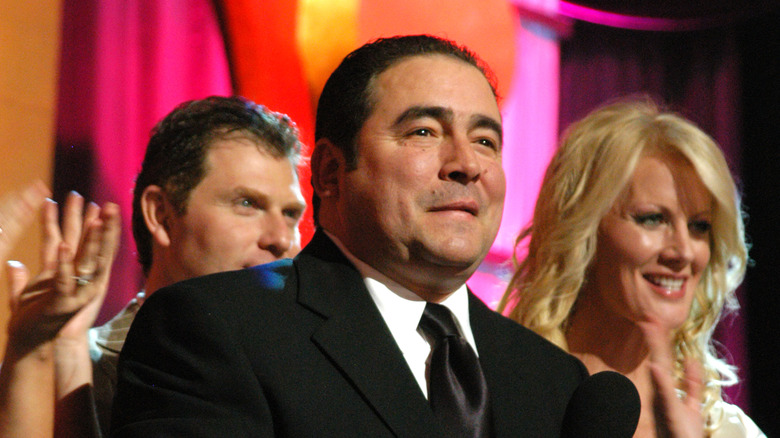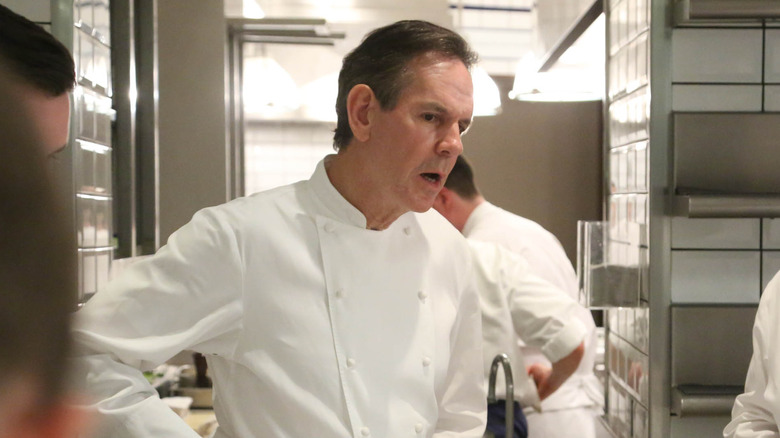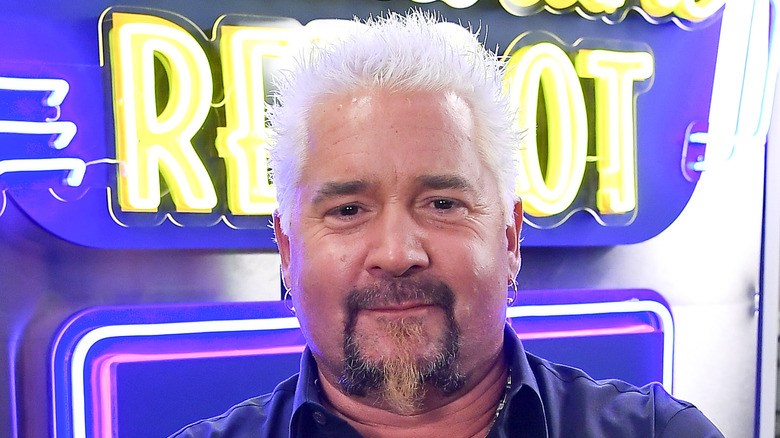11 Top Chefs Who've Been Slammed By Critics
The best chefs in the world are often rewarded with TV fame, big money, and flashy restaurants bearing their name. None of that, however, can guarantee immunity from the one thing that they surely fear most: a terrible review from an influential critic.
How much damage can one bad review do? Besides a blow to their egos, negative reviews can also be awful for business. Medium reports that one unfavorable review, in fact, can nix more than 20% of a restaurant's customers. In a world where restaurant overheads can already be precipitously low, that's a potential disaster. The advent of social media has only made things worse, too, says Medium. After all, it seems that unhappy patrons are more likely to share their opinions than people who were pleased with their experiences.
At least some critics understand the weight their words can carry. Former New York Times reviewer Craig Claiborne has been quoted in the New Yorker as saying: "It burdened my conscience to know that the existence or demise of an establishment might depend on the praise or damnation to be found in the Times." Meanwhile, celebrity chef and Momofuku restaurant group founder David Chang has referred to current New York Times restaurant critic Pete Wells as "the judge and jury" of a budding establishment.
Telling it like it is, however, happens to be their job, however sour the truth may be. Read on for some of the most brutal honesty top chefs have been served.
David Humm's new menu was destroyed
Not only has Eleven Madison Park been named the best restaurant in New York City, but it was also once deemed one of the best in the world, receiving four stars from the New York Times. But in May 2021, chef Daniel Humm made a stunning announcement: Eleven Madison Park would be going vegan when it reopened, a decision he reached during the Covid pandemic, reports the New York Times. Speculation grew to a fever pitch. Could the venerable establishment maintain its excellence without dishes that included stalwarts like pork, seafood, and poultry?
According to the New York Times, the resounding answer is "no." Critic Pete Wells, who had once praised Humm as a "virtuosic handler," of duck liver, eviscerated Humm's new menu in a September 2021 review that was so dramatically unfavorable, it quickly went viral. One beet dish, Wells determined, "tastes like lemon pledge and smells like a burning joint." He went on. "Time and again," he wrote, "delicate flavors are hijacked by some harsh, unseen ingredient," while perversely "doing things no root vegetable should be asked to do."
He also knocked the prices on the menu, pointing out that Eleven Madison Park was still charging $335 for dinner while getting rid of items that cost the most, like caviar, lobster, and foie gras. The Internet's jaw was left agape. "This is not a review," one person noted on Twitter. "It's a murder on paper for the whole world to see."
Bobby Flay was shaken to the core
Bobby Flay is not someone you'd normally associate with a confidence problem. Handsome and charming, he's not only a (now seemingly former) Food Network star, but he's also romanced a number of gorgeous, high-profile women. Yet his ego took a big hit when his Tex-Mex eatery, Mesa Grill, received a major ding by the New York Times, which deducted one of its two stars in 2008.
In addition to disparaging the food, which reviewer Frank Bruni said "devolve into a redundant, vague haze of smokiness and syrupiness," he also took a personal swipe at Flay, questioning whether Flay's ballooning celebrity had become a distraction. "I wonder," Bruni wrote, "if Mr. Flay had taken his eye off the grill." Mesa Grill eventually closed.
Years later, in an interview with CBS News, Flay confessed the review had gutted him completely. he told reporter Tracy Smith he had been in a taxi when he heard the news. "It was a long day," he recalled. "I got really drunk that night." In a 2021 podcast with his daughter, Sophie, he also added that it had been, "literally one of the worst days of my life." What stung the most, he recalled, is that Bruni's assessment hit home. "The bottom line is he said that I took my eye off of the restaurant and maybe he was right."
Andrew Zimmern's Chinese restaurant got taken down
To say Andrew Zimmern's first solo eatery, St. Paul, Minnesota's Lucky Cricket, had its work cut out for it would be an understatement. Prior to its opening, Zimmern had been forced to apologize after offending many in the Asian food community by referring to midwestern Chinese food as "horsesh-t." So by the time his own restaurant opened for business, people already had their metaphorical knives out. Haters jumped at the chance to dub it "Unlucky Cricket." Less predictable, however, was the terrible reaction to the food itself, which Zimmern had promised would "take guests on a journey and showcase the authentic flavors of the Chinese foods that I love" (via Food & Wine).
Critics felt less than transported, however. The restaurant received plenty of poor reviews, but the standout takedown had to be from the lifestyle magazine Growler, whose descriptions of the various dishes dripped with disgust. Even Lucky Cricket's plain rice "tasted strongly and unmistakably of cigarette ash," while the fried rice, which was "room temperature and undercooked," was agonizingly chewy.
Meanwhile, dumplings were too doughy, noodles were "dead in the water," and the roast duck was so unidentifiable that the waiter first mistook it for pork belly, then beef, before finally landing on the right protein. Growler predicted Lucky Cricket wasn't likely to survive. Most brutally of all, it was right. After temporarily closing a year after it opened, it closed for the second time in 2020 and remains shuttered.
The essence of Emeril Lagasse was eviscerated
It wasn't just a restaurant that New York Times writer Amanda Hess decided to investigate in 2008. Rather, it was the very ethos of chef Emeril Lagasse himself. At the time, no one, it seemed, could get enough of the Food Network's rising star or his exclamatory signature catchphrase: "Bam!"
Hess, for her part, was skeptical of the hype. So she attended his show tapings, tasted his food, and tried his recipes. And when the time came to publish her findings in the New York Times, she took no prisoners, blackening his name like a piece of Cajun catfish. While in the studio for an episode of "Emeril Live," she sampled a turkey sandwich that had other audience members swooning. "It was," declared Hess, "a very bad turkey sandwich."
She was equally unimpressed with his attention to detail. "Mr. Lagasse rarely starts and finishes a recipe in a linear or comprehensive fashion," she noted. "He uses no measurements, skips crucial steps and is vague in his instructions." She dismissed the products he promotes — like his line of rubs and mixes — as completely unnecessary and declared his overindulgent takes on classic dishes, like cheesy mashed potatoes, as "ghastly" and "downright suicidal." He was untalented, disrespectful of tradition, and sloppy, Hess concluded. "If you're hoping to learn much from Emeril Lagasse," she surmised, "don't get your hopes too high."
Masaharu Morimoto became a laughingstock
When "Iron Chef" star Masaharu Morimoto reigned as executive chef of New York City's preeminent Japanese restaurant, Nobu, he was the toast of the town. Unfortunately, the reviews of his next restaurant, Tribeca Canvas, turned him into the joke of it. Described as Morimoto's spin on American classics, the menu at Tribeca Canvas featured items such as corn dogs, macaroni and cheese, and chicken pot pie, all married with Asian influences.
Now, the playfulness of such dishes probably would have been lauded, if only reviewers actually liked them. Overwhelmingly, it seemed, they did not. Adam Platt at Grubstreet rather gently opined that Morimoto had perhaps grown too focused on appealing to trends and had forgotten factors like quality and taste.
Surprisingly it was the downtown hipster outlet the Village Voice, a paper known for its support of artistic creativity and the challenging of norms, that savaged it the most. Critic Tejal Rao had no love for the restaurant's corn dogs, remarking that you'd find "finer corn dogs from a box." The gyoza? Those Japanese-style dumplings were "like a sickly school of fish, their bloated bellies wreathed in garlands of overwrought carrots." Morimoto's light-hearted attempt at an American menu, he concluded, was less "Top Chef" and much more TGI Friday's.
Gordon Ramsay's Fat Cow was slaughered
When notoriously irritable chef Gordon Ramsay arrived in the U.S., his reputation quickly caught fire. His show, "Hell's Kitchen," became such a hit that it inspired several spin-offs and led to a series of lucrative production deals for Ramsay with Fox (via Hollywood Reporter). He became a regular on late-night talk shows, got a Hollywood makeover, and even entertained a lighthearted Twitter feud with a muppet.
But, amongst all that hubbub, he lost one significant fan: Besha Rodell of LA Weekly, who made a point of expressing her disdain for Ramsay's newfound celebrity status when reviewing his restaurant Fat Cow in Los Angeles' The Grove shopping center.
In short, she accused the once-esteemed British chef of becoming a sell-out, pointing to everything from his "bad, pandering," TV shows to his recent affinity for Botox. Nothing suffered more, she alleged, than the quality of the food with his name on it. Even by mall fare standards, she wrote, Fat Cow was a big disappointment. She picked many of the individual dishes apart for their terribleness (including a ceviche that looked "like a science experiment gone wrong") but overall, her true beef was that Ramsay had allowed fame to destroy his culinary street cred. For her, that was "the real reason this restaurant is more offensive than the sum of its not-very-good parts."
Giada De Laurentiis burst into tears
A surefire way to make Giada De Laurentiis start crying? Pick on her chicken cacciatore.
Actually, the cacciatore was just one of several dishes that critic Pete Wells of the New York Times found less than average during a 2014 visit to De Laurentiis's eponymous Las Vegas restaurant. Wells' disproving words apparently hurt her feelings so much that De Laurentiis, normally quick to flash a toothy smile while tossing her hair (and a bowl of pasta) on TV, shed tears. Speaking to the Eater Upsell podcast years later, she confessed that she had spent "two days bawling my eyes out," over Wells' review. "It was not pretty."
Besides her signature cacciatore, Wells was similarly unexcited by two more of De Laurentiis' specialties: her pizzas and pasta. Noting that De Laurentiis had fired her head chef just two weeks after opening, he recommended she get someone in there to improve on both. Ouch. Her Sin City restaurant survived the harsh criticism and is still currently open for business, but De Laurentiis remains horrified by the awful review, telling Eater, "I was immensely upset. It really killed me for a while."
John Tesar flew into a rage
As a contestant on "Top Chef" seasons 10 and 14, John Tesar's skin was thick enough to help him survive multiple eliminations — but it wasn't enough to withstand a few sharp words from a critic he didn't like. In reviewing his local restaurant, Knife, back in 2014, Leslie Brenner of the Dallas Morning News awarded it three stars out of five, a rating that would more than satisfy most chefs. She did, however, nitpick, with the Dallas Observer reporting that she took issue with some of the steaks, chicken, and salads. She was also not a fan of Knife's oversize menu.
Tesar, to put it mildly, completely lost it. According to the Los Angeles Times, he immediately declared Brenner persona non grata. "That woman is not welcome at any of my restaurants," he posted on Facebook. "Leslie Brenner clearly does not understand what Knife is all about."
Days later, Tesar continued with an expletive-laden Twitter rant, per the LA Times. "@lesbren *** you! Your reviews are misleading, poorly written, self serving, and you have destroyed the star system and you really suck," Tesar wrote. Note to self: when dining at a John Tesar restaurant, don't send a dish back.
Thomas Keller's star restaurant was shamed
While some chefs take to Twitter when troubled by a bad review, others put pen to paper. This is what happened when Thomas Keller of New York's Michelin-rated Per Se was on the receiving end of a blistering 2016 review by New York Times critic Pete Wells (yes, him again). During a recent visit, Wells recounted poor service and disappointing food, including a bouillon broth he compared to "bong water." That all made, in his opinion, the $325 tasting menu "seem like extortion." Savagely, Wells removed two of the restaurant's four stars, sending shockwaves through the culinary industry.
In an interview with Town & Country shortly after Wells' write-up went to print, Keller admitted that it had been "devastating." After two weeks of silence, he posted a lengthy apology to the restaurant's guests that read, in part: "We are sorry that we let you down." Beyond that, he also wrote a remorseful private letter to Wells, the contents of which he did not disclose. However painful, it had also been a humbling learning experience, Keller said, conceding that "maybe we were too complacent."
Jamie Oliver's Italian chain was torpedoed
Sometimes, a terrible review rattles not only the nerves of a celebrated chef but his entire staff. That seemed to be the case when the Sunday Times' Marina O'Loughlin paid a visit to an outpost of Jamie Olivier's restaurant chain, Jaime's Italian, in 2018. Olivier had previously rocketed to fame as Britain's rakish "Naked Chef," due not to actual nudity, but to his laid-back, uncomplicated approach to cooking. In a similar spirit, his Jamie's Italian restaurant franchise aimed to offer authentic Italian food at reasonable prices. Sounds like a noble idea right? Not in execution, according to O'Loughlin.
Her description of Oliver's tagliatelle with truffles was so detailed in its ire that it was quickly reprinted everywhere. "Appalling," she declared. "A honking, salty swamp of a sauce, brown and dusty with nutmeg. Tiny chunks, not shavings, of tasteless black truffle lurk around, like mouse poos in soup."
The BBC reports that, a mere eight months after O'Loughlin's review, Jamie's Italian began its financial collapse. Morale drastically fell, too. "We knew it wasn't doing as well as we'd want it to be," one staffer recalled. Not long after, many employees lost their jobs, as BigHospitality reported that Jamie's Italian had closed 12 of its 37 locations.
Guy Fieri got what may have been the worst review ever
No list of terrible high-profile restaurant reviews would be complete without the one that, nearly 10 years later, remains the gold standard for brutal culinary take downs. While hardly considered a master of haute cuisine, Guy Fieri, the host and star of Food Network's "Diners, Drive-Ins and Dives" is inarguably a recognizable name in the world of food.
As startling as his signature blonde, spiked hair-do was his sprawling New York restaurant, Guy's American Kitchen & Bar, located in Manhattan's tourist-filled Times Square. Why New York Times critic Pete Wells decided to pay it a visit, we'll never know. But his review was so acidic that the Today Show even ran a segment questioning if Wells perhaps went too far.
Where to begin? For starters, Wells asserted that the dishes listed bore little resemblance to what later showed up on the plate and that "few things on the menu can be eaten without fear or regret." The restaurant's cocktails, meanwhile, were compared to radiator fluid mixed with formaldehyde. Entrees were described as "gray", "deadened", and "deeply unlovable." Worst of all, Wells said that some dishes came to the table cold. According to Wells, the dessert also tasted like fish and the waitstaff appeared confused. His overall rating, naturally, was a jaw-dropping zero stars. Fieri defended the restaurant, but it never regained its footing, eventually closing several years later, forever associated with perhaps the worst review in modern restaurant history.











